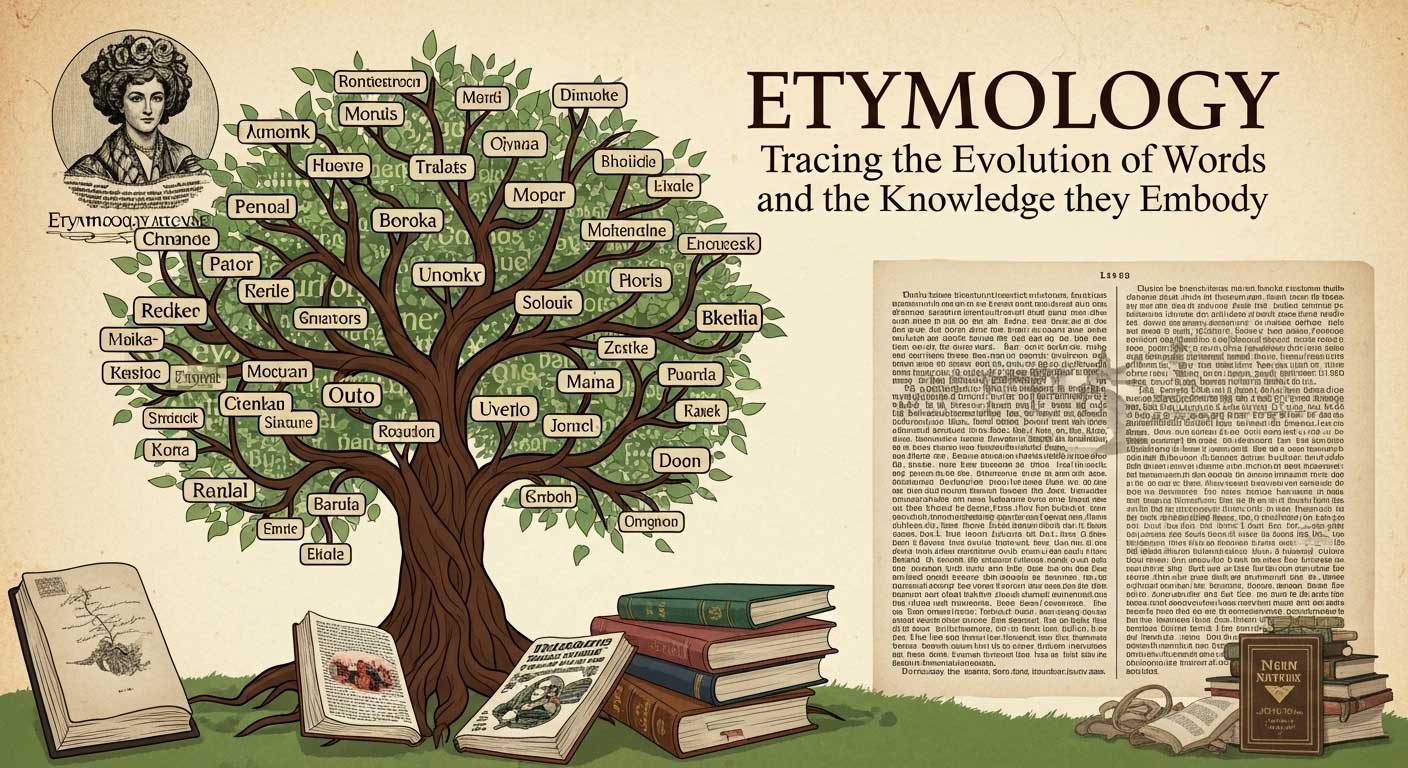This article embarks on an exploration of etymology—the scientific study of the origin, history, and evolution of words. The very name of the discipline, derived from the Greek étymon (“true sense”) and -logia (“study of”), reveals its foundational ambition: the “study of the true meaning.” This quest for truth is a direct reflection of the evolution of human thought itself. We will trace its path from an art of witty wordplay in antiquity to a rigorous science in the 19th and 20th centuries, and now, into a new frontier driven by Artificial Intelligence. By examining the life history of words, we uncover the history of the cultures that spoke them, revealing a detailed record of their technological advancements, social transformations, and scientific discoveries.
Part I: The Principles and Processes of Word-History
This section establishes the foundational methodologies that define etymology as a scientific discipline. It details how etymologists reconstruct the past and the fundamental ways in which language itself changes over time.
The Etymologist’s Toolkit: From Philology to the Comparative Method
Modern etymology is a complex analytical process that draws upon multiple streams of evidence. These methods form an interlocking system of inference, allowing linguists to reconstruct linguistic histories with high confidence.
- Philological Research: The cornerstone of etymological inquiry is philology—the meticulous analysis of historical texts. Ancient records provide direct evidence of a word’s earliest form, spelling, and context.
- Dialectological Data: The study of regional dialects provides another crucial source of evidence. A pronunciation or word form lost in a standard language may be preserved in a more conservative or isolated dialect, acting as a living window into the past.
- The Comparative Method: This powerful tool establishes genetic relationships between languages to reconstruct unattested ancestor languages (proto-languages). It involves identifying cognates (words in related languages from a common ancestor), establishing regular sound correspondences, and reconstructing a proto-form (e.g., Proto-Indo-European *deḱm for “ten”).
- Internal Reconstruction: This complementary technique infers an earlier stage of a single language by analyzing patterns of irregularity within that language itself, without comparison to other languages.
- The Study of Semantic Change: Etymologists hypothesize how a word’s meaning has evolved, testing these ideas against a general body of knowledge about common types of semantic shifts observed across many languages.
A robust etymological conclusion is rarely based on a single piece of evidence. Its scientific rigor lies in the convergence of all these evidentiary streams, allowing etymologists to reconstruct linguistic events for which there are no direct observers.
| Methodology | Description | Primary Use | Limitations |
|---|---|---|---|
| Philology | The study of language in historical written sources to trace a word’s form and meaning over time. | Documenting the history of words in languages with long literary traditions. | Dependent on the availability and accuracy of written records. Cannot be used for pre-literate periods. |
| Dialectology | The study of linguistic variation across geographical regions. | Identifying archaic forms or meanings preserved in regional dialects. | Data can be complex and dialect boundaries are often fluid. |
| Comparative Method | A systematic technique for comparing related languages to reconstruct their common ancestor (proto-language). | Establishing genetic relationships and reconstructing proto-forms. | Relies on the assumption of regular sound change and can be skewed by undetected borrowings. |
| Internal Reconstruction | A method of inferring an earlier stage of a language by analyzing irregularities within that language alone. | Reconstructing pre-historic features where comparative evidence is ambiguous or unavailable. | Less powerful than the comparative method; can only reconstruct changes that have left traces. |
Mechanisms of Linguistic Evolution: How Words Are Born and Transformed
The methods of etymology trace several fundamental processes that drive linguistic evolution.
- Borrowing (Loanwords): One of the most significant sources of new words is adoption from other languages due to cultural contact, trade, or conquest. The English language is a prime example, with its vocabulary a rich tapestry of Germanic roots and borrowings from Latin and French.
- Word Formation: Languages create new words from existing resources through two primary mechanisms:
- Derivation: Forming a new word by adding an affix (prefix or suffix) to an existing root, such as deriving unhappy, happily, and happiness from the root happy.
- Compounding: Creating a new word by joining two or more independent words, such as keyboard, desktop, and housecleaner.
- Semantic Change: This is the evolution of a word’s meaning over time, often driven by cultural or technological shifts. For example, the word mouse acquired a new meaning with the advent of personal computing.
- Phonetic Change: Words evolve in their physical form through changes in pronunciation, which can be gradual shifts (like Grimm’s Law) or more abrupt modifications (like clipping memorandum to memo).
These mechanisms reveal that words are dynamic cultural artifacts. Their life stories are a direct and traceable record of human interaction and thought. To study etymology is to reconstruct the history of the cultures that spoke them, making an etymological dictionary not merely a list of definitions, but a museum of a culture’s past.
Part II: The Evolution of Etymological Thought
This section traces the intellectual history of the discipline itself, from ancient speculation to modern science.
Ancient Foundations: Speculative Etymology
In ancient India, the grammarian Pāṇini (c. 6th-4th C. BCE) created a comprehensive, scientific grammar of Sanskrit. His work was preservative, designed to codify the sacred language of the Vedas with unparalleled formal rigor. In stark contrast, Greek etymology was an extension of philosophy, centered on the debate in Plato’s Cratylus: is the link between a word and its meaning natural (physis) or a matter of convention (nomos)? This led to speculative etymologies used to support philosophical arguments. The Roman tradition continued this model, often using etymology to legitimize Rome by linking Latin to prestigious Greek dialects.
The Birth of a Science: The Neogrammarians
The 18th and 19th centuries transformed etymology into a science. In 1786, Sir William Jones proposed that Sanskrit, Greek, and Latin sprung from a common source, establishing the foundation for the Indo-European language family. Scholars like Jacob Grimm codified the principles of regular sound change (Grimm’s Law). This culminated in the 1870s with the Neogrammarians, who championed the principle of the “exceptionlessness of sound laws,” giving historical linguistics the rigor of a natural science.
| Date/Era | Key Figure/Development | Core Contribution |
|---|---|---|
| c. 6th-4th C. BCE | Pāṇini | Authored the Aṣṭādhyāyī, a generative grammar of Sanskrit with unprecedented scientific rigor. |
| c. 380 BCE | Plato | Wrote the Cratylus, framing the debate between “natural” vs. “conventional” word meaning. |
| 1786 CE | Sir William Jones | Proposed that Sanskrit, Greek, and Latin share a common ancestor, establishing the Indo-European language family. |
| 1822 CE | Jacob Grimm | Formulated Grimm’s Law, codifying systematic consonant shifts in Germanic languages. |
| 1870s | Neogrammarians | Championed the principle of the “exceptionlessness of sound laws,” establishing methodological rigor. |
Twentieth-Century Paradigms: From Structuralism to Cognitive Linguistics
The 20th century reshaped the theoretical landscape for etymological research.
- Structuralism: Ferdinand de Saussure distinguished between diachronic (historical) and synchronic (static) linguistics. He argued that language is an interconnected system where each element’s value is defined by its relationship to other elements.
- Generativism: Noam Chomsky shifted the focus to language as a cognitive phenomenon, proposing an innate “Universal Grammar.” His work provided powerful new formal tools for modeling how grammatical rules change over time.
- Functionalism & Cognitive Linguistics: In reaction to abstract formalism, these schools view language as a tool for communication (Functionalism) or an emergent property of general cognitive processes (Cognitive Linguistics). They link language change directly to human experience and conceptual metaphors.
Part III: Etymology as a Cross-Disciplinary Nexus of Knowledge
The study of word origins has profound applications across a wide range of fields, providing a key to understanding the history of our ideas, institutions, and discoveries.
Unlocking Meaning in the Humanities: Literature and Philosophy
In the humanities, etymology is an indispensable analytical tool. For writers, it unveils deeper resonances in a text. For example, knowing that disaster literally means “ill-starred” (from Italian dis-astro, “bad star”) adds a layer of cosmic fatalism. In philosophy, etymology is a form of intellectual archaeology. Tracing a word’s history reveals the evolution of the ideas, beliefs, and worldviews of the cultures that shaped it. The word philosophy itself, from Greek for “love of wisdom,” encapsulates an ancient debate about the nature of knowledge.
Codifying Concepts in the Sciences: Biology and Chemistry
In the sciences, etymology plays a constructive role, building precise and unambiguous systems of nomenclature. In biology, taxonomy uses Latin and Greek roots to create a stable, universal framework. In chemistry, the naming of elements reflects the history of their discovery, drawing from mythology (Thorium), places (Polonium), properties (Hydrogen, “water-former”), and scientists (Einsteinium).
| Field | Term | Etymological Breakdown | Significance |
|---|---|---|---|
| Biology | Taxonomy | Greek taxis (“arrangement”) + nomos (“law”) | The name defines the field as the “law of arrangement.” |
| Chemistry | Hydrogen (H) | Greek hydro- (“water”) + -gen (“forming”) | Describes the element’s key property: it forms water. |
| Medicine | Cardiology | Greek kardia (“heart”) + -logia (“study of”) | A transparent compound defining the specialty. |
Interpreting the Past, Shaping the Present: The Role of Etymology in Law
Legal language is inherently historical, with terms from Latin, Norman French, and Old English. This makes etymology crucial in legal interpretation, particularly in the U.S. constitutional theory of Originalism. This theory argues that legal texts must be interpreted according to the “original public meaning” of their words. This transforms legal questions into problems of historical linguistics, such as determining the 18th-century meaning of “to keep and bear Arms.” This creates a high-stakes battleground where linguistic analysis has immediate consequences for public policy, highlighting the risk of the etymological fallacy—the flawed idea that a word’s only “true” meaning is its original one.
Part IV: The Algorithmic Frontier: Computational Etymology and AI
The latest transformation in studying word origins involves computational methods and artificial intelligence.
From al-Khwārizmī to Modern Computing: The Etymological Roots of the Digital Age
The language of the digital age reveals a deep history of knowledge transmission. The word algorithm is not from Greek but is a Latinized version of the name of the 9th-century Persian mathematician Muhammad ibn Mūsā al-Khwārizmī. His work, which introduced the Hindu-Arabic numeral system to the West, also gave us the word algebra from the Arabic term al-jabr (“reuniting broken parts”). These words are a direct linguistic record of a pivotal moment of knowledge transmission from the Islamic Golden Age to medieval Europe.
Automating Discovery: AI in Cognate Detection and Phylogenetic Reconstruction
AI is now being applied to core tasks of historical linguistics. Automated Cognate Detection (ACD) uses machine learning to identify words across languages with a common origin. This data feeds into computational phylogenetics, which uses statistical techniques borrowed from evolutionary biology to reconstruct the “family trees” of languages, estimating their relationships and ages with unprecedented scale and speed.
New Horizons and Inherent Limitations: What AI Can and Cannot Reveal
The promise of AI lies in its ability to analyze vast digital corpora to trace subtle semantic shifts and uncover historical patterns. However, its power is matched by limitations. AI models are dependent on training data, making them vulnerable to scarcity for ancient or low-resource languages. They can also inherit biases from historical texts and often lack true cultural context. The future is not human obsolescence but human-AI symbiosis. The AI will handle large-scale data processing, while the human expert will generate hypotheses, critically evaluate the output, and provide deep historical interpretation.
Conclusion: Etymology as a Mirror to the Evolution of Knowledge
This report has traced the intellectual journey of etymology, from the ancient quest for a word’s “true meaning” to the modern application of the algorithm. This journey is a microcosm of the broader evolution of human knowledge itself. We have seen etymology’s function shift across disciplines: as an interpretive key in the humanities, a constructive tool in the sciences, and a politicized instrument in law. The current AI-powered frontier promises to unlock new discoveries but demands a critical partnership between human expertise and machine processing. In this synthesis, the timeless quest to understand our words—and through them, ourselves—will continue, enriched and transformed by the very technologies whose names tell a story of millennia of human inquiry.











